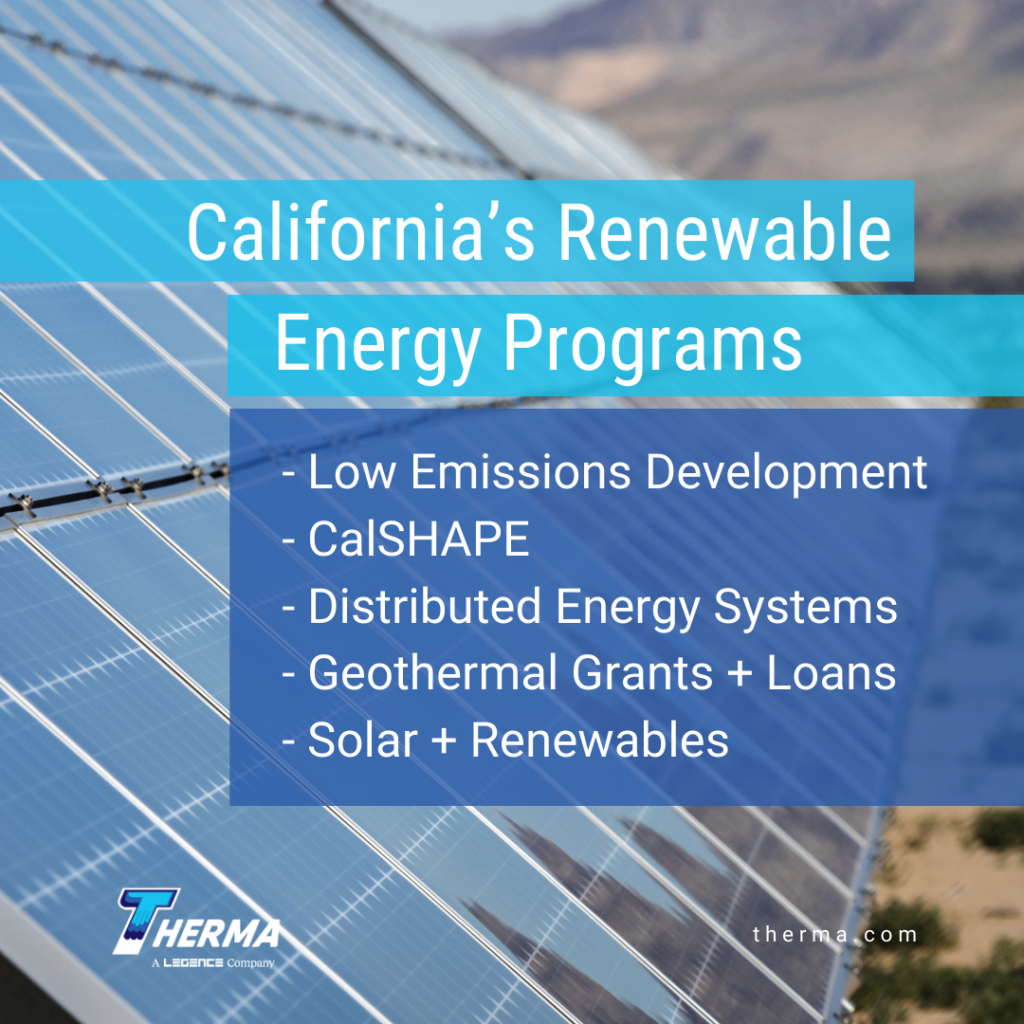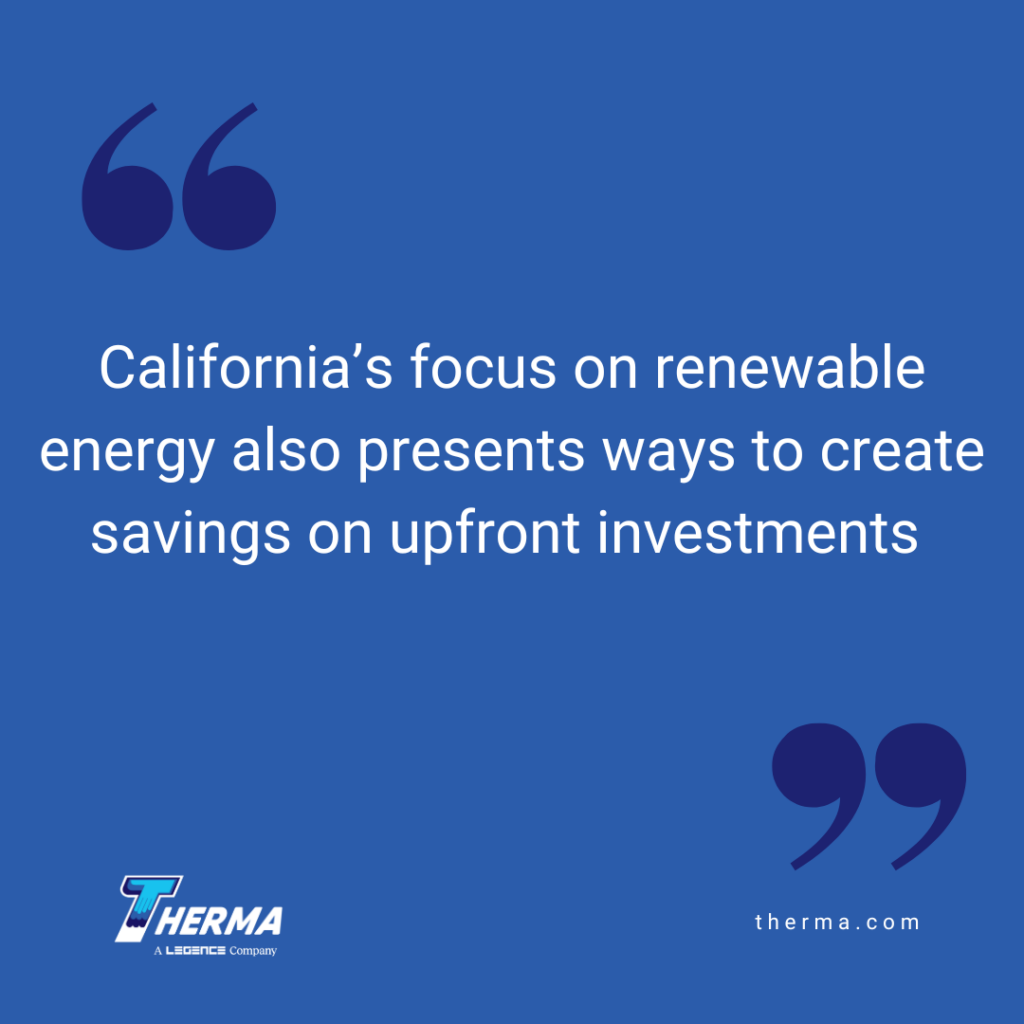by Ali Kriscenski
California’s ambitions for decarbonization present opportunities for business owners to improve energy performance across their facilities. The collective measures to track and reduce energy usage can be used by businesses, and homeowners, to survey energy efficiency and implement cost-effective strategies for energy and cost savings. California’s focus on renewable energy also presents ways to create savings on upfront investments. In this article, we’ll take a look at California’s initiatives and how to utilize its tools and incentives.
California’s Renewable Energy Programs
California is a national leader in renewable energy and climate change actions. Led by the Energy Commission, California develops programs towards renewable energy, including incentives and grants to enable new technology and energy efficiency upgrades.
Low Emissions Development
Among the California Energy Commission’s programs is the Building Initiative for Low-Emissions Development (BUILD). This program focuses on building decarbonization by creating incentives for utilizing new technologies that reduce carbon emissions. BUILD projects include single and multi-family residential projects, including low-income housing. The BUILD program provides a number of incentives related to avoiding GHG emissions, increased building efficiency, and solar photovoltaic (PV)energy.
CalSHAPE
The California Schools Healthy Air, Plumbing, and Efficiency Program (CalSHAPE) is a comprehensive program that increases water conservation, HVAC efficiency, and improves wellness levels for schools. Capital upgrades through CalSHAPE help manage moisture levels by replacing older plumbing that meets new standards. This measure improves water efficiency but also helps control contaminants such as mold and mildew which can result from excess condensation or water leaks. The ventilation program of CalSHAPE helps offset the costs for HVAC assessments, maintenance, CO2 monitoring, repairs, and other improvements that contribute to healthier, more efficient educational facilities.
Distributed Energy Systems
In recent years, the combination of extreme weather and outdated or overburdened utility systems has revealed the need for robust, distributed energy systems that can prevent disruption and provide emergency services. California’s Distributed Electricity Backup Assets (DEBA) Program provides incentives to improve and increase distributed energy systems that reduce demand on the state’s electrical grid. The projects within the DEBA Program can include low-emission strategies such as fuel cells and renewable energy.
Geothermal Grants and Loans
As a readily available, consistent source of thermal energy, geothermal HVAC systems are an excellent option to improve energy efficiency, resiliency, and indoor environmental quality. Geothermal HVAC harnesses thermal energy from within the ground or nearby water bodies and circulates the energy throughout a building or facility. These systems require a small amount of electricity but otherwise run emission-free without exhaust from combustion. The current grants and loans program can include construction projects and also research-focused projects to expand the knowledge base for implementing geothermal resources.
Solar and Renewables
In addition to facility and building upgrades, California is developing a number of programs to incentivize solar and renewable energy technologies in residential, commercial, and agricultural settings. Initiatives include automated solar permitting, grants for renewable energy, and opportunities to supply renewable energy. For example, programs like the Renewables Portfolio Standard set procurement guidelines to include renewable energy as a portion of operating requirements.
Planning for System Upgrades
While it may seem daunting to navigate California’s energy programs and requirements, the state’s initiatives present opportunities for lowering the costs of capital investments. The best place to get started is to look at recent surveys of your building or facility equipment, energy usage, and operating costs. Compare investment timelines with the incentives offered through California’s Energy Programs to find opportunities for alignment. This process will help identify priorities, funding opportunities, and return on investment for renewable technology and initiatives.
Enlisting a Trusted Energy Partner
As California expands its energy programs and initiatives, the benefits of finding an experienced partner to provide guidance on energy, water, and facility management become a cost-effective business investment. Therma’s team of experts can provide professional insight on capital investments for water and energy efficiency improvements. They can also help align your facility’s long-term planning goals with the state’s Renewable Energy Programs, identifying opportunities to utilize state grants, loans, and other financial incentives toward your company’s strategic growth. Contact Therma today to learn more.
AUTHOR BIO
Ali Kriscenski was trained in high-performance building design at Boston Architectural College. She has worked with leading architecture and construction firms in NYC and New England and served on the executive team at the Forest Stewardship Council International. She was the managing editor at Inhabitat and has worked pro bono for the Green Building Institute, ISEAL Alliance, and Habitat for Humanity.
Sources
CA Energy Commission – Renewable Energy
Earth.Org – How California is Leading the Renewable Energy Transition in the US
National Renewable Energy Laboratory (NREL) – California’s Clean Energy Resources and Economy









